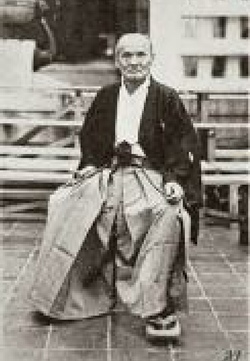

What is a (B) Kata?
Kata: Kata is the Japanese term that corresponds to “Classical Technique” in the Nihon Goshin Aikido system.
Aikido training begins with repeated practice of kata until the waza are sufficiently internalized (or mastered).
[Kata is fundamental movements in Aikido, typically involving two partners, in which nage applies specific waza (often translated rather incompletely as 'technique') on uke repeatedly.]
In kata practice, the nage and uke follow movements that have been agreed upon in advance. Uke is a 'tackling dummy' ~ just there for the ride. He does not resist the efforts of Nage at any point.
Historically, there are two basic methods are known in the practice of kata: (A) kata is practiced and performed in a flowing fashion as precisely as possible, usually following the demonstrations of a master instructor; (B) kata is practiced as a prototype of some basic waza.
[In Japan, two different characters are often used to differentiate these two types of kata (A) and (B). In the traditional martial arts of the bygone centuries, the latter concept (B) was preferred.]
(A) The first concept is applied in kata practice in most Aikido schools.
(B) The second concept (the traditional prototype) was emphasized by Shodo Morita, Soke and Richard Bowe, Shihan. This (B) kata is the foundation of the Classical Techniques of Nihon Goshin Aikido, and the fundamental part of our training (which later incorporates the first concept). In the (B) kata, the student practices the prescribed technique on both sides, not just on the right or the left side. After the student has sufficiently mastered the basic kata, the manner of attack (by uke) can undergo variations (these are Applications)
It helps to see applications as (A) katas in that they provide a real world scenario, and ensure the mastery of the (B) kata adapted for different circumstances.
Students in the art of Nihon Goshin Aikido are urged to practice kata in this manner (B) first, then (A), without implying any prejudice against other Aikido organizations.
The 50 (B) kata that make up the Classical Techniques allow for consistent transfer of the knowledge base, anchor the art, and protect the unique brand of Nihon Goshin Aikido.
The source material for this article is slightly modified from its original source ~ Aikido America International/N.A.K., a coalition of schools that follow the training system developed by Professor Kenji Tomiki, the founder of the Nihon Aikido Kyokai (Japan Aikido Association): http://www.aikidoamerica.org/randori.html
Takeda Sōkaku
A (B) Kata man.

As important as the (B) kata is to our art, I believe that focusing on (B) Kata ~ at the expense of training in (A) Kata applications ~ does a potential disservice to the NGA practitioner, and our art in general.
When you read comments from traditional aikido guys who have trained with someone from our style, a consistent comment you will pick up on is that we are often perceived as “stiff” in our application of technique.
In my mind, “stiffness” is the implication of the early learning process of the Classical Techniques gone wrong ~ or at least a symptom that study of the inevitable, and more martial, (A) Kata is being neglected.

Here is my attempt at a video explanation of the Classical Technique, and it’s role in student development.

2014 - 2021 ngaexperience.com

Sensei John Carter explains the Classical Technique ~ it’s purpose ~ T-Ball Training:” ~ Using Slap to the Side of the Head as the Technique. Includes some applications also (two hand jacket grab, round house punch, jacket grab & punch.
